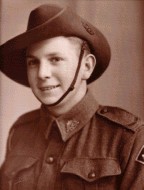 |
 |
![]()
| 8th Division Signaller (POW) (David Vernon Rodda) |
| who became a Doctor Post War |
 |
David Vernon Rodda (VX63738) was born in Wodonga on 4 September 1923. He was educated at country Primary Schools, then Ivanhoe Grammar School as a boarder until 1940. After working as a telegraphic clerk with the AWA Beam Wireless, he enlisted in the AIF on 20 September 1941 and underwent training at Bonegilla. On 28 Nov 1941 he embarked on the Marella leaving Melbourne for Singapore, but was delayed in Darwin. Subsequently the Marella moved troops from Darwin to Port Moresby where they transshipped to the Aquitania. The ship then sailed around the continent via Sydney and Fremantle to Sunda Straits where the 4,000 troops transhipped to smaller Dutch vessels. They arrived in Singapore on 24 January 1942. Just three weeks later (15 February 1942) he, with thousands of others, was a Prisoner of War of the Japanese. |
In May 1942, after 3 months in the Changi prison camp, David was amongst a party of 3,000 Australians who were shipped to Burma as part of a group known as “A” Force. He was initially landed at Victoria Point where he worked on repairing the Tavoy airfield. At the end of October he went by ship to Moulmein, then via Thanbyuzayat to camps for the construction of the Burma Thailand Railway.
David was with this force until it got to the 60 kilo area. He was evacuated back to 55 Kilo Camp where, because of his poor state of health, he remained for some months. It was at this camp that he had contact with Lt Col Coates. There were other Australian doctors, but David does not recall their names.
Following completion of the railway the force, including David, was moved by train to the southern end in Thailand. He then spent a period of time in the Tamakan camp. It was from this location that he was selected to go to Japan as labour for Japanese industry. The route to get to Japan was rather convoluted. Moved to Bangkok, Phnom Penn and Saigon where the ship’s captain, who was to take them to Japan, refused to leave harbour. In June 1944, “The Japan Party” moved back by train to Singapore where the first part left by ship for Japan in Sept 1944. The convoy was attacked by American Submarines . David was in the remainder of the Party which sailed in Dec 44 and arrived safely in Japan after a month at sea. He did not know of the fate of the others.
In Japan he was at Camp 17 Omuta, Kyushu, where he worked in the coalmine. (Other POWs in this Camp worked in a zinc foundry).
At wars end David returned to Australia. The POWs went by train to Nagasaki, then US aircraft carrier to Okinawa, US troop ship to Manila, where they stayed for some weeks. Catalina flying boat took some to Darwin via Bougainville. Finally a B24 bomber took them to Melbourne, .
In 1946 he did some matriculation subjects. During that time he became a committed Christian and was led to study medicine at Melbourne University, graduating in 1952. He then did a year at the Alfred Hospital and one at Geelong Hospital as Registrar.
From 1955 to 1965 he served as a Medical Missionary in Tanzania. It was here that he met and married Gwen. On their return to Australia David went into General Practice for 3 ½ years in Berwick. From 1969 until 1974 he served with the Mental Health Authority of Victoria and then with the Mount Royal Geriatric Hospital until 1985, when he took early retirement due to visual problems.
2005 David and Gwen reside in Kew East, Victoria. David has been working on his War Diary, including memories of POW life.
Article prepared by Lt
Col Peter Winstanley OAM RFD (Retired) JP following
telephone interviews and email exchanges.
Email address peterwinstanley@bigpond.com
Web page www.POWs-of-Japan.net
|
|